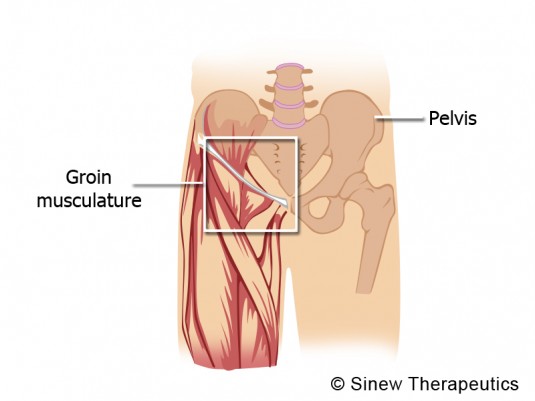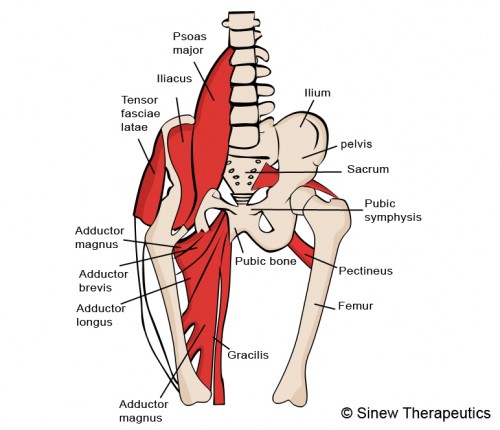A groin strain is also referred to as a groin pull, pulled groin, or abductor strain. It’s a very common in athletics that require a great deal of jumping, running, or sudden changes in movement direction. Football, soccer, gymnastics, and hockey for example. Groin strains comprise about ten percent of all hockey injuries and about five percent of all soccer injuries.


Groin Pulled/Strained
Anatomy As It Relates To Pulled/Strained Groin Muscles
The hip adductors are a powerful muscle group located in the groin area. The group is comprised of three short adductors going from the pelvis to the thigh bone (the pectineus, adductor brevis and adductor longus) and two long adductors going from the pelvis to the knee (the gracilis and adductor magnus).
As the name “adductors” implies, the main function of the group is adduction. Adduction involves pulling the lower extremities back toward the body midline. Any movement that requires a quick directional change involves the adductors. Normal movement, such as walking, also involves the adductors pulling the leg in motion toward the midline, so that balance is maintained.
What Is A Groin Strain?
When one of the adductor muscles are torn or abnormally stretched past their normal excursion, it causes a strained groin. This injury is the result of putting too much stress on muscles or tensing them too quickly or too forcefully. It can occur in everyday accidents, such as a fall. However, the causative movement is most often during a forced side-to-side push-off where there is a rapid and sudden directional shift in the opposite direction, a motion that causes the adductor muscles to forcefully contract.
Grades Of Groin Muscle Tears
Like all muscle tears, groin strains are graded one through three. The ranking is representative of how severe the groin strain is. There are general corresponding symptoms for each grade, based on the degree of the tear.
Grade I
Less than 10% of groin muscle fibers are damaged. Represents groin strains that involve severe stretching or minor tearing. Symptoms for a grade one muscle strain include the following:
* mild pain or discomfort over the inner thigh
* little, if any, loss of strength and movement
* groin may feel abnormally tight
* injured area will usually be slightly tender to touch
Grade II
Greater than 10% of the groin muscle fibers are torn, but there’s not a complete tear or rupture. Symptoms of a grade two muscle strain include the following:
* moderate pain and discomfort over the inner thigh
* possible function limitation during movement (especially running and jumping)
* swelling
* bruising
* tightening of the adductor muscle injured
Grade III
A complete tear or rupture of a groin muscle. Symptoms of a grade three groin muscle strain include the following:
* may feel a popping sensation during the injury
* significant to severe pain (especially when walking)
* loss of function
* muscle spasm
* significant swelling
* significant bruising
* may not be able to contract the groin muscles (bring or squeeze the legs together)
Strengthening Exercises
These Groin Exercises are ideal to build strength and flexibility.
Massage Treatment
These Groin Massage Techniques are of great value in pain relief; circulation stimulation; dispersing blood and fluid accumulations; swelling reduction; and relaxing muscle spasms, especially when used alongside the Sinew Therapeutics liniments and soaks.
ACUTE STAGE SYMPTOMS AND TREATMENT
This stage is characterized by swelling, redness, pain, and possibly a local sensation of heat, indicating inflammation. If coolness makes your pain feel better, then the Acute Stage Treatment is recommended.
ACUTE STAGE SYMPTOMS:
The acute stage starts the moment an injury occurs and lasts until the swelling and inflammation are gone. The swelling is the result of the blockage of blood, tissue fluids and circulation in the groin because their normal movement has been disrupted by the force of the injury. Just like cars back up behind a traffic jam, causing congestion, exhaust and overheating; blood and fluids back up behind the injured groin, causing pain, inflammation, lumps and swelling.
The sensation of heat is due to the warming action of the blood and fluids overheating in the injured groin as they back up and accumulate. Stiffness and decreased mobility are due to spasms in tendons and ligaments that have contracted reflexively beyond their normal range from the impact of the injury.
As ligaments and tendons stretch and tear, blood from ruptured blood vessels becomes trapped in the local tissues. As the trapped blood clots up, it sticks the tissues together creating adhesions. Adhesions cause pain, inflammation and restricted movement because the layers of tissue that used to slide smoothly across one another now adhere and snap which interferes with normal functioning. It is essential to break up clotted blood as quickly as possible to prevent adhesions and scar tissue from forming.
During the acute stage it is very important to restore normal circulation to the groin, break up clotted blood and stagnant fluids, reduce swelling, and reduce the redness and heat associated with inflammation. By restoring the flow of blood, fluids, and circulation in the groin, then pain is relieved, damaged tissues can regenerate with healthy functional tissue, and the groin can strengthen and regain it's mobility.
ACUTE STAGE TREATMENT:
1. Apply the Sinew Herbal Ice on your groin to reduce redness, swelling, and inflammation while dispersing accumulated blood and fluids to help restore normal circulation to the groin. This first-aid treatment is used in place of ice to significantly speed up the healing process. It reduces the swelling and inflammation more effectively than ice, allowing you to more quickly regain range of motion. Acute Sinew Liniment can be used in-between applications.
Ice is not recommended because it does not help repair damaged tissues and keeps everything in the injured area frozen, causing the stagnation of blood and fluids and the contraction of muscles, tendons and ligaments. In Chinese sports medicine ice is not used and is considered a culprit in injuries that donít heal well.
2. Massage your groin with Acute Sinew Liniment to relieve pain, reduce swelling and inflammation, break up clotted blood and stagnant fluids, and stimulate circulation of blood and fluids to help cells quickly repair damaged tissues. Sinew Herbal Ice can be used in-between applications.
3. The Sinew Sports Massage Oil is recommended for use before and after exercise, sports and strenuous activity. It warms and stimulates your muscles, increases circulation and relieves tightness, hence improving your performance and helping to prevent injury.
CHRONIC STAGE SYMPTOMS AND TREATMENT
This stage begins once the swelling and inflammation are gone, but you still feel pain, stiffness, weakness, and/or sensitivity in cold and damp weather. If heat makes your pain feel better, then the Chronic Stage Treatment is recommended.
CHRONIC STAGE SYMPTOMS:
The chronic stage begins once the swelling and inflammation are gone, but you still feel aching pain and stiffness. This is because there are still accumulations of stagnant blood and fluids in your groin that are blocking circulation and blood supply to damaged tissues, creating residual pain, stiffness and weakness. You may actually feel hard nodules like sand in the tissue, indicating accumulation, calcification, and adhesions, which all cause pain, stiffness, and joint instability.
Your groin may feel more sensitive to the cold and ache in cold and damp weather due to impaired circulation. These symptoms are often the result of failure to treat the injury properly from the outset and overicing.
Increasing circulation and blood supply to the damaged tissues is very important in treating chronic injuries because tendons and ligaments do not have an extensive direct supply of blood. That is why chronic injuries can be slow to heal. Increasing local circulation also prevents cold and dampness from penetrating the injured area, preventing pain and stiffness.
During the chronic stage it is very important to break up remaining accumulations of blood and fluids, and increase circulation and blood supply to the damaged tissues. By increasing circulation and blood flow in the groin, then pain and stiffness is relieved, and the damaged tissues can strengthen to restore stability.
CHRONIC STAGE TREATMENT:
1. Massage your groin with Chronic Sinew Liniment to relieve pain and stiffness, strongly stimulate circulation and blood flow to damaged tissues, and promote the healing of overstretched tendons and ligaments. The Sinew Relaxing Soak can be used in-between applications.
2. Soak your groin with the Sinew Relaxing Soak to relax muscles and tendons that are in spasm, ease joint pain and stiffness, and improve range of motion. The Sinew Relaxing Soak is particularly useful if you feel spasms in your groin. The soak can be used by saturating a towel in the liquid and applying it to your groin. Chronic Sinew Liniment can be used in-between applications.
3. The Sinew Sports Massage Oil is recommended for use before and after exercise, sports and strenuous activity. It warms and stimulates your muscles, increases circulation and relieves tightness, hence improving your performance and helping to prevent injury.







